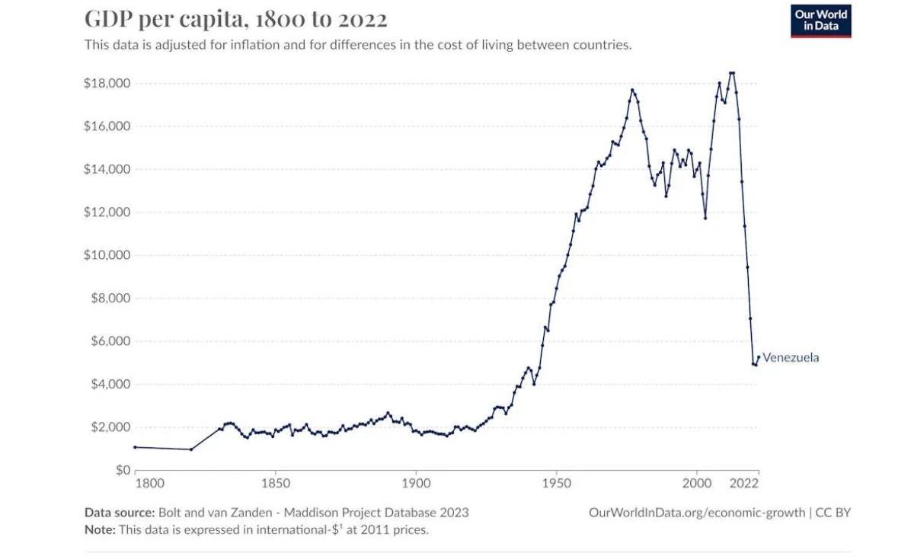In recent weeks, the debate over Venezuela has intensified, largely due to the military pressure that the Trump Administration has placed on Maduro’s regime. This has led various political figures, journalists, and analysts to revisit Venezuela’s recent history and the causes that drove the Maduro regime to provoke the worst economic collapse ever recorded in the Western world — an 80 percent GDP contraction in less than a decade. The crisis becomes even more shocking when considering that Venezuela holds the world’s largest proven oil reserves.
As with Cuba, defenders of the Venezuelan regime have attributed the country’s economic collapse to US sanctions — which they incorrectly call a “blockade” — rather than to the political, economic, and social model imposed by the United Socialist Party of Venezuela. That model brought massive state controls, expropriations, corruption, persecution of the opposition and the press, the destruction of the rule of law, and the elimination of judicial guarantees for investment.
Recently, Dr. Steve Hall, a professor at Teesside University in England, argued on X that US sanctions were responsible for Venezuela’s economic deterioration. After facing widespread criticism, he made his account private — but this was the chart he shared:
The graph shows that starting in the year 2000, Venezuela’s economy began to surge, driven by a sharp increase in oil prices. When Hugo Chávez and his socialist movement came to power, oil traded at around $18 per barrel, due largely to the Asian financial crisis at the end of the 1990s. However, in 2003, following the US invasion of Iraq, OPEC cut production, and several global catalysts pushed prices above $100 per barrel — granting the Venezuelan regime unprecedented wealth, which it used to consolidate power at home and finance the “expansion of the revolution” across Latin America.
The Five Phases of Socialism
For years, I’ve explained the five stages socialist economies go through once they take power:
Euphoria
Peak Prosperity
Reality Shock
Collapse into Misery
Stabilization of Poverty and Totalitarianism
In Venezuela’s GDP chart, we can see each phase unfold clearly.
When Chávez came to power, the regime “redistributed” part of the oil windfall through populist missions that temporarily reduced poverty. But soon came the heavy economic regulations, price controls, expropriations, rampant corruption, redistribution without investment, and uncontrolled money printing. Over time, the country entered phase three — the “reality shock” — when the regime’s repressive nature became evident, poverty deepened, and the process of stabilizing misery and consolidating totalitarianism began.
In Venezuela’s case, phase three began around 2011, phase four around 2013, and phase five — the totalitarian stage — emerged in 2014. That same year, Venezuela’s mass migration crisis exploded, driven by poverty and political repression.
In 2014, not a single sanction had yet been imposed on the Chávez regime. Still, Venezuela recorded a 4.8 percent GDP contraction and 68.5 percent inflation. In 2015, President Barack Obama imposed the first individual sanctions against regime officials — freezing assets and revoking visas — but the US continued to buy Venezuelan oil, and the country still traded freely with the world. This remained the case until 2019, when President Donald Trump finally sanctioned the state oil company PDVSA, freezing its US assets and banning transactions with American entities.
However, even before that, in 2018 — when there were still no oil sanctions — Venezuela suffered hyperinflation exceeding 130,000 percent and a GDP drop of 19.6 percent. By then, millions of Venezuelans had fled, fuel lines stretched up to 48 hours, blackouts occurred daily, and shortages of basic goods spawned a black market for deodorant, toilet paper, milk, and meat.
The Counterintuitive Effect of Sanctions
Economic sanctions are used by Washington as a coercive tool to punish anti-democratic regimes and US adversaries by cutting off their financial lifelines to weaken or destabilize them. However, in Venezuela’s case, sanctions had a paradoxical effect — they triggered a brief economic rebound.
Let me explain briefly.
Venezuela is officially a narco-state led by Nicolás Maduro. Conservative estimates suggest that corruption by regime officials has siphoned off more than $500 billion — money that for years was diverted or invested in Europe and the United States.
When broader economic sanctions were finally applied, the regime was forced to lift many of its rigid economic controls in order to survive. For several years, a de facto “anarchic market” emerged in Venezuela — to the point that outlets like The New York Times and Bloomberg mistakenly claimed that Maduro was “turning toward capitalism.”
In reality, Chávista elites, pressured by sanctions, had to withdraw their fortunes from the US and Europe and reinvest them inside Venezuela. They needed to repatriate capital, launder money, and at the same time ease the severe shortages afflicting the country.
Although it was technically “illegal” to trade in US dollars or any currency other than the bolívar, these restrictions were effectively abolished, along with import and export controls. Markets quickly filled with imported goods, private-sector wages rose, local production slightly recovered, and after an 80 percent GDP plunge over a decade, Venezuela saw small signs of economic life.
In their struggle for survival, and spurred by sanctions, Maduro’s regime dismantled much of the socialist economic control apparatus — unintentionally allowing market forces to partially heal the damage caused by decades of socialist mismanagement.
Thus, while one can debate whether sanctions have been effective in weakening an anti-democratic, criminal regime, what cannot be argued is that sanctions caused the worst economic collapse ever recorded in the Americas. The full responsibility lies with socialism itself.
